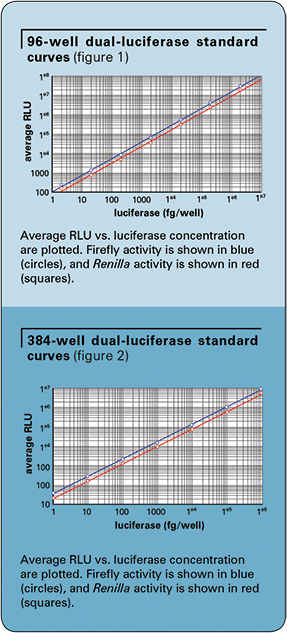
Application Note
Dual-Luciferase assays in 96- and 384-well formats on the new SpectraMax L
By Cathy Olsen, Ph.D.
Introduction
Reporter gene assays are used to study the expression of eukaryotic genes. In dual reporter gene assays cells are transfected with two vectors, the first containing an experimental reporter gene coupled to a regulated promoter of interest, and the second containing a control reporter gene coupled to a constitutive promoter. Normalizing the activity of the experimental reporter to the control reporter minimizes experimental variability.
Bioluminescent reporter systems using firefly and Renilla luciferases are widely used as co-reporters because both assays are easy to run and exquisitely sensitive. Promega’s Dual-Luciferase® Reporter Assay System allows users to measure both firefly and Renilla luciferase activity in a single microplate well, with firefly acting as the experimental reporter and Renilla the control. Both reactions can be easily measured in Molecular Devices’ new SpectraMax® L microplate luminometer. This instrument is ideal for measuring dual luciferase assays in both 96- and 384-well plates, and SoftMax Pro® software simplifies data collection and analysis with preconfigured protocols. An example of dual-luciferase assay results obtained in SpectraMax L is presented here.
Materials
- Firefly luciferase (Sigma Cat. #L9506)
- Renilla luciferase (Chemicon Cat. #4400)
- Dual-Luciferase Reporter Assay System (Promega Cat. #E1960); contents include Luciferase Assay Buffer II, Luciferase Assay Substrate, Stop & Glo® Buffer, Stop & Glo Substrate, and 5x Passive lysis buffer
- White 96-well and 384-well Lumitrac 200 microplates (Greiner Cat. #655075 and #781075)
- SpectraMax L microplate luminometer with SoftMax Pro software (Molecular Devices)
Methods
Passive lysis buffer was prepared by diluting the 5x stock in deionized water. The Firefly luciferase stock (1 mg/mL) was prepared in phosphate-buffered saline (PBS) containing 1% bovine serum albumin (BSA) and frozen in aliquots at -70°C until use. Aliquots were thawed as needed and a 10 µg/mL standard prepared by diluting 10 µL of the 1 mg/mL stock with 990 µL passive lysis buffer. The Renilla luciferase stock (10 µg/mL) was prepared by adding 990 µL passive lysis buffer to a 10-µg vial of the enzyme and mixing gently. The solution (10 µg/mL) was divided into aliquots and frozen at -70°C until use. The dual luciferase working standard #1 was prepared by diluting 10 µL each of the 10 µg/mL firefly and 10 µg/mL Renilla luciferase with 980 µL passive lysis buffer (concentration of each enzyme = 100 ng/mL). Serial one-to-ten dilutions in passive lysis buffer yielded working standard concentrations from 10-5 to 10-1 pg/mL for both enzymes. Luciferase Assay Reagent II (LAR II) and Stop & Glo Reagent were prepared according to the Dual-Luciferase Reporter Assay System technical manual.
The P injector of the SpectraMax L was primed with 1.2 mL of LAR II, and the M injector was primed with 1.2 mL of Stop & Glo Reagent. In SoftMax Pro, Dual Read mode was selected. Both the P and M injectors were set to deliver 100 µL (96-well plate) or 25 µL (384-well plate), with a 2-second delay and 10-second integration time. 20 µL (96-well plates) or 10 µL (384-well plates) of each luciferase standard was pipetted into assay wells, with enzyme concentrations ranging from 2 fg/well to 2x106 fg/well (96-well plate) or 1 fg/well to 106 fg/well (384-well plate). Each assay plate was placed in the drawer of the SpectraMax L and the read was initiated. Data analysis and graphing were performed using SoftMax Pro software.
Results
Figure 1 illustrates results obtained for a dualluciferase assay performed in a 96-well plate. The dynamic range of this assay spanned about five orders of magnitude. Sensitivity is excellent, as shown by the linearity of the assay down to the lowest standards. In 384- well assays (Figure 2), the results were similar, demonstrating the SpectraMax L to provide exceptional reagent mixing and sensitivity in the lower-volume format.

Summary
The SpectraMax L is a dedicated luminescence microplate reader offering outstanding sensitivity, flexibility, automation capability, and validation tools. With its dual high-velocity liquid injectors, SpectraMax L can perform both flash and glow luminescence detection applications in 96- and 384-well formats with ease. It is suitable for assay development and high-throughput applications, especially when paired with Molecular Devices’ StakMax™ microplate stacker. We have demonstrated here that dual-luciferase assays can be run on 384-well format, enabling significant reagents savings without compromising sensitivity.
For more information, visit our web site at www.moleculardevices.com/spectramax or email Cathy.Olsen@moldev.com